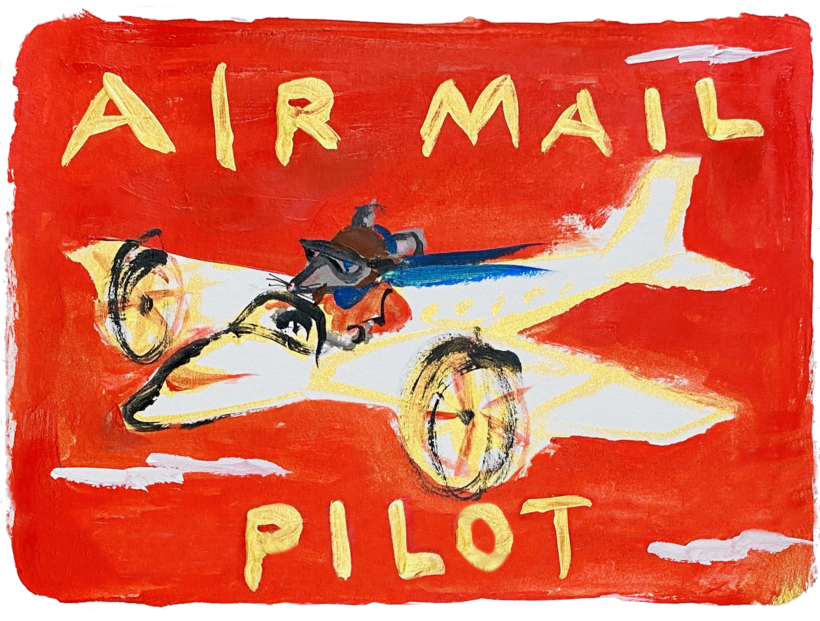The Dog Who Doesn’t Bite Her Tongue

“Want play outside.”
That’s a three-year-old talking, but not the sort of toddler you’re probably thinking of. This three-year-old is a dog named Stella, whose owner taught her how to “speak” by using the same technology that helps human kids who have trouble learning to talk.
Stella doesn’t actually say words, not even in the “ruh-roh” way Scooby-Doo does. And she doesn’t have a collar that translates for her like Dug, the dog in Up. Instead, Stella makes herself understood by using her paws to push big buttons that play pre-recorded words, one button per word. So when she “said,” “Want play outside,” Stella had to push each of those three buttons.
All the buttons are placed next to one another on the floor, in a grid that looks like a large play mat. On videos, you can see Stella’s thought process, kind of, as she decides where to walk to push the next button.
Stella, who lives near Chicago, is part Australian cattle dog, which means she’s a distant cousin to a Dingo, and has the tall pointy ears to prove it. Her owner is a woman named Christina Hunger, who used to work as a speech therapist for kids. When she and her husband got Stella as a puppy, Hunger noticed that Stella was demonstrating the same types of pre-verbal communication skills that very young children use—things like body language (wagging her tail or flattening her ears, in Stella’s case) and vocalizations (whimpering, barking, growling). On the one hand, what’s the big deal? All dogs do that stuff. On the other hand, most aren’t blessed with owners who think in terms of pre-verbal communication skills.

“I had this light bulb moment,” Hunger told The Washington Post. “Dogs can understand words, shouldn’t they have an opportunity to say words, just in a different way—not with verbal speech?” That’s when she got the idea to try out the techniques she used with kids on her pet.
“Outside” was the first word Christina taught Stella—a good, practical word if you’re a dog and have to pee. Stella now knows 48 words, including emotion words, like “love” and “mad,” and question words, like “where,” so that she can ask for a “toy” or “blanket.” She’ll combine up to five to make crude sentences that might be grammatically incorrect but get her meaning across. It’s not so different from the way people text.
According to Christina, Stella’s most complex sentence—so far—is “Christina come play love you.” She tapped that out when Christina’s husband was going to take her for a walk and she wanted Christina to come along, too. It makes you wonder: By adding “love you,” was Stella trying to make her owner feel guilty?
“I think this can go a lot farther than we have discovered yet,” said Christina, who’s just published a book titled How Stella Learned to Talk. “There’s been research that dogs can understand hundreds and even upward of 1,000 words. So I’m thinking if they understand these words, maybe when given the right tools, they could potentially say that many words as well. We’ll see!”
AIR MAIL Pilot promises to report back to you if and when Stella has the vocabulary and inclination to explain why dogs sniff one another’s butts.
Under Her Wing

Wigging Out

Until just a few years ago, it was commonplace for Hollywood film studios to use stuntmen in wigs for female roles, instead of hiring stuntwomen. The practice even had a name: wigging.
That all began to change in 2017, when American stuntwoman Deven MacNair filed a discrimination complaint against a production company and an actors’ union which chose a male double to perform a stunt for an actress on a set MacNair had been hired on. MacNair lost the case, but she ignited a cultural shift.
When France’s Campus Univers Cascade (C.U.C.), which calls itself the world’s biggest stunt school, opened in 2008, female applicants were scarce. Now women make up nearly one-third of the school’s student body. “We’re getting more and more girls,” Michel Bouis, a teacher at C.U.C., told The Times of London.
And the demand from studios and streaming services like Netflix, Disney Plus, and Amazon Prime is growing, too. Female superheroes and characters who can leap over buildings, dodge bullets, and navigate complicated fight sequences are increasingly common in scripts. “There are heroines who fight now, so we need girls,” Bouis says.

Malik Diouf, another teacher at C.U.C., noted how female students are often getting snapped up even before completing the 24-month course. “As soon as they have the slightest skills, they leave directly to work with the Americans or the English,” Diouf told Reuters.
Valeriane Michelini, 29, who trained as a dancer before attending C.U.C., says, “I’m used to thriving in a graceful and feminine world. And now, I’m in quite the opposite.” Marine Dolle, 24, is also studying at C.U.C. and finds stunt work both exciting and rewarding. “It’s choreographed, it’s calculated, it’s technical,” she told Reuters.
The entire industry has evolved. “We don’t need wigs anymore,” Lucas Dollfus, the director of C.U.C. told Reuters. “The women are badass in any case.”

